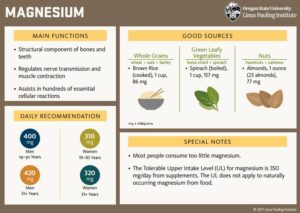Magnesium plays important roles in the structure and the function of the human body. The adult human body contains about 25 grams (g) of magnesium. About 50 to 60% of all the magnesium in the body is found in the skeleton and the remainder is found in soft tissue, primarily in muscle. Magnesium is the second most abundant intracellular cation after potassium. Blood contains less than 1% of total body magnesium. Only the free, ionized form of magnesium (Mg2+) is physiologically active. Protein-bound and chelated magnesium serve to buffer the pool of free, ionized magnesium.
Magnesium is involved in more than 300 essential metabolic reactions, of which the followings are the most important: energy production, synthesis of essential molecules, structural roles (in bone, cell membranes, and chromosomes), ion transport across cell membrane, cell signaling and cell migration.

Can You Test Your Magnesium to Check if You Are Deficient?
Magnesium (Mg) deficiency is common but many people still want to know if this can be tested or confirmed in any way. The published literature says that “there is no simple, rapid and accurate laboratory test to indicate the total body magnesium status”. The commonly used blood tests (i.e. serum magnesium) are not sensitive enough to pick magnesium levels inside various cell types (red blood cell, muscle etc.). It is important to point out that a person can still have “suboptimal” total magnesium levels without any lab finding that is out of range. Most experienced clinicians don’t bother using conventional testing methods to assess magnesium deficiency but rather use clinical signs and symptoms (i.e. muscle twitches, palpitations, chronic pain, high blood pressure etc.) to determine deficiency and a need for extra magnesium.

Why is Magnesium Such a Common Deficiency?
A gradual depletion of nutrients from our soils has left many plants (vegetables, nuts, whole grains and seeds) with lower levels of magnesium. Large-scale and non-sustainable agricultural practices only use nitrogen based fertilizers to maximize crop yield rather than quality and neglect to restore trace minerals back into the soil.
Our drinking water is also devoid of magnesium because the filtration and water-treatment removes the naturally occurring magnesium. Both tap and bottled water have little or no magnesium and higher levels of fluoride (which binds magnesium) and calcium, both of which can worsen magnesium deficiency. Despite eating a healthy and well-balanced diet a person can develop low magnesium levels over time. The recommended daily allowance (RDA) for magnesium in adults is 4.5 mg/kg/day (about 300 mg/day). A dietary surveys suggest that many North Americans do not get the minimum recommended amounts of magnesium daily. Even though the classic symptoms of severe magnesium deficiency are rare, health issues can occur well before overt deficiency.
Another factor that contributes to magnesium deficiency is that it is depleted by a number of common digestive disorders. Since magnesium is absorbed in the small intestine conditions that affect this area of the gastrointestinal system, such as Crohn’s disease, intestinal surgery, and gluten sensitivity (celiac enteropathy) and other conditions can impair absorption.

Many commonly used medications, such as proton pump inhibitors, diuretics and some antibiotics cause magnesium depletion. Proton pump inhibitors (i.e. Omeprazole/Losec®, Esomeprazole/Nexium®, Lansoprazole/Prevacid®), block stomach acid which is required for the absorption of magnesium (HCL breaks the chemical bond between magnesium and the anion). Some of these drugs are taken for a long time or repeatedly, which can create a substantial deficiency. This is especially concerning when many elderly are on multiple medications for many years. Older adults are at an increased risk for magnesium deficiency since intestinal absorption of most nutrients can decrease with age.

How many types of magnesium are out there?
Magnesium oxide: Often used in milk of magnesia products since this form has a strong laxative effect. Even though this combination contains a large proportion of magnesium compared to the oxide molecule, it has poor bioavailability and readily causes loose stools; therefore it is considered the least optimal form to use as a supplement.
Magnesium sulfate: This form is often used as an intravenous preparation but it is not used in oral formulations. Since it does have some absorbability through the skin, it is also found in Epsom bath salts.
Magnesium citrate: A commonly used form that has a good bioavailability compared to oxide. It is also very rapidly absorbed in the digestive tract but it does have a stool loosening effect. This form is found in many supplements and remains a good option for delivering magnesium into the body.
Magnesium Aspartate: This form has increased bioavailability compared to oxide and citrate. There were some promising clinical trials conducted in the 1960s that found a combination of magnesium and potassium aspartates had a positive effect on fatigue and they reduced muscle hyper-excitability. Physiologically this makes sense since both magnesium and aspartic acid are critical players in cellular energy production. This form is not commonly found but has been used for chronic fatigue syndrome.
Magnesium Glycinate: Glycine is a well-known calming amino acid. This combination has good bioavailability and does not have a laxative effect since glycine is actively transported through the intestinal wall. Due to the calming and relaxing effect of both glycine and magnesium, this combination has been used successfully for chronic pain and muscle hyper tonicity.
Magnesium Malate: This less well-known combination has been studied for use in fibromyalgia. Since malate is a substrate in the cellular energy cycle, it can help improve ATP production; there is some preliminary evidence that it may reduce muscle pain and tender points in fibromyalgia patients.
Magnesium Orotate: This is another relatively unknown chelate combination containing orotic acid. This form has good bioavailability has had been studied specifically for heart health. Orotates can penetrate cell membranes, enabling the effective delivery of the magnesium ion to the innermost layers of the cellular mitochondria and nucleus. Orotates themselves increase the formation of RNA and DNA which can help heart cells repair and therefore improve function. The combination has been shown to improve heart failure, symptoms of angina and exercise performance in clinical trials.
Magnesium Taurate: Both magnesium and the amino acid taurine share the ability to improve cardiac function; each has a potentiating effect on insulin sensitivity and also a calming effect on neuromuscular excitability. The actions of both have striking similarities when it comes to cardiovascular health. They both have blood pressure reducing effects, stabilize nerve cells, improve the contraction of the heart muscle and have an anti-thrombotic effect. Additionally, low levels of vitamin B6 have been shown to further deplete both magnesium and taurine.
Magnesium-L-Threonate: This form of magnesium has recently been studied to improve memory and brain function. One preliminary study in animals found that it significantly enhanced both short-term and long-term memory, boosting scores by 15% for short-term memory and 54% for long-term memory compared to magnesium citrate. Based on this study, it appears that magnesium-L-threonate is a highly absorbable form of magnesium that can improve brain function. While this research is promising, more is needed to confirm its benefit.
Magnesium Picolinate: This form of magnesium has generated interest because it is very inexpensive and can easily be made into a liquid supplement. There really have not been any substantial research trials supporting its specific health benefits. The down side of this form is that the picolinate molecule does not have any additional health benefits.
